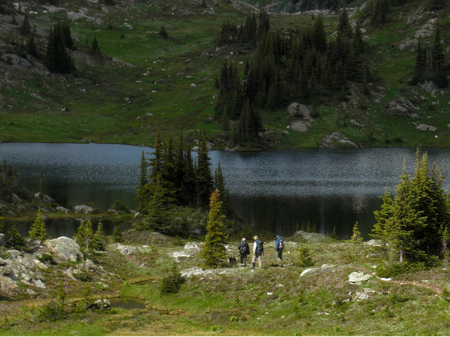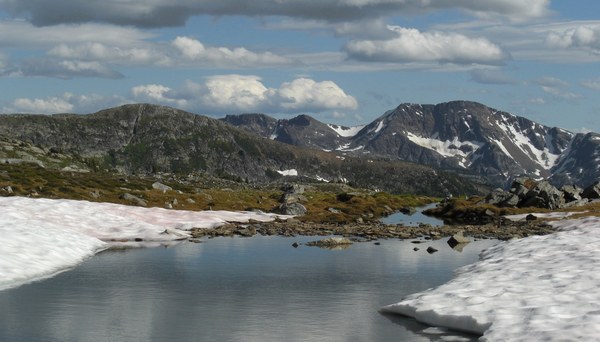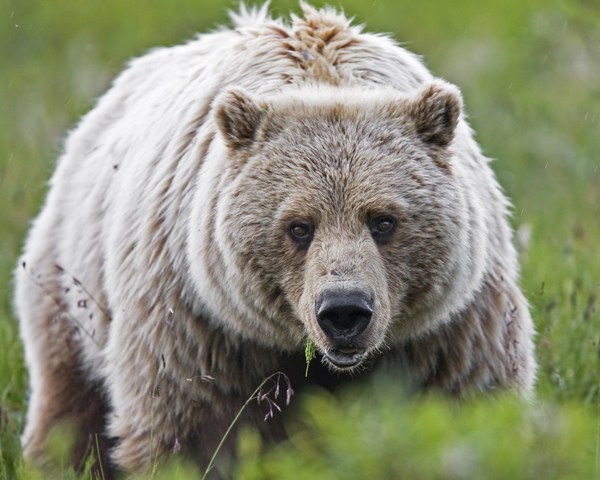
“This was his country, clearly enough. To be there was to be incorporated, in however small a measure, into its substance - his country, and if you wanted to visit, you had better knock.”
-John McPhee, Coming into the Country
Wells Gray Provincial Park is one of Canada’s most impressive natural areas, spectacularly wild country couched beneath towering mountains, snow-capped even in August. I had the joy of experiencing it on a 6-day backpacking trip in 2014 with a group of Seattle Mountaineers, and in October 2019, I persuaded my wife, Gail, to return with me for an autumn adventure.
I rhapsodized at length on the beauty of the park, explaining that she would find many lovely areas to paint autumn’s multicolored splendor while I hiked some of the trails I remembered from my previous adventure. I admit to a strange compulsion, borne of a combination of “getting on in years” (now 78), and a constant fear of imminent destruction of the wild places I treasure. I like to return to as many of such lands as I can if only to know that, for now at least, they are still intact. No bulldozers allowed!
 The Trophy Mountains. Photo by Jason Hollinger.
The Trophy Mountains. Photo by Jason Hollinger.
Wells Gray Provincial Park
Our first day there delivered a spectacularly beautiful morning, the sun blazing high above the crystal waters of Clearwater River and a light breeze orchestrating a dazzling dance of gold and red along the river’s edge. With Gail safely settled at a lovely viewing spot near our cabin, I stopped by the Wells Gray Information Centre. I explained to the attendant that I wanted to hike back, alone, to a meadow that I remembered from my backpacking trip near Trophy Mountain. She knew exactly where I meant and handed me a finely-detailed map.
“The Alpine Meadows road is an old logging road that is not maintained year-round. The recent rains have probably rutted the higher portions of it, and it rises steeply past the first right-hand turn. Do you have a four-wheel drive vehicle? High clearance?”
“I have a small, front-wheel drive Honda, and while it’s pretty good on steep trails, it’s not what my Seattle friends call a ‘mountain car.’ And low clearance, I am afraid. More of a city car.”
“Well, your choice. Just be careful is all. Definitely don’t want to get stuck up there. It’s 7.5 kilometers to the parking lot at the trailhead, and this time of year you’re not likely to find anyone else up there. And there is no cell phone service either, so you would not be able to call a ranger if you got in any trouble. Days are really short this far north now, and we are having an unusually cold October. The sun today feels really warm, but once it sets behind Buck Hill up there, it will get much colder very fast.”
“I understand. I’ve got an early start, so I should be all right. Any wildlife up there this time of year?”
“Not much. Most deer and elk are feeding in the lower portions of the park now. No reports of cats or bears, but then as far as I know no one has been up there for quite a while. So, I can’t really say for sure.”
“OK, thanks for your help. I’ll try to stop back here later today.”
“Sure thing. Enjoy your hike. Like I said, just be careful.”
The meadow
The road up to the parking lot was indeed severely rutted and seemed steeper than I remembered from my previous visit. I passed a clear cut I did not recall, a depressing sign that logging had resumed on the perimeter of the park.
The parking lot was indeed deserted and sprinkled with snow. As I stepped out of my car I realized that despite the brilliant autumn sun, the mountain air was much colder than in the lowlands. Frozen puddles dotted the sandy lot; the temperature was below freezing. But after a difficult drive in my “city car,” I was now exactly where I wanted to be: about to hike to a high meadow that had long lingered in my memory. I paused for a moment to reflect on how absolutely alone I suddenly was. While I had hoped that I would have this day to myself, I was also acutely aware of my vulnerability amid the vast wilderness surrounding me. And, of course, the cold.
The initial two kilometers of the trail rise gradually through a lush pine and fir forest. Red-yellow leaves from scattered oak and cottonwood trees twirled and tumbled in the gentle breeze. Such an immaculate autumn day, I thought. Crisp, cool, bright; I rattled off in my mind all the adjectives I could muster for this day. Though I was walking a well-traveled trail cut deeply into the frozen ground, because I was alone, I fancied myself an intrepid explorer climbing toward an unknown vista.
Beyond the forest, the meadow explodes in all directions. To the northeast, 2,577-meter Trophy Mountain lords over its domain. Table Mountain looms farther to the northeast. Beneath these majestic mounds lay my remembered destination, Trophy Alpine Meadows, more demure now in the fall than in its resplendent summer glory, but inviting nonetheless. The trail continues to rise due north, creating the sensation of walking off directly into the horizon and falling into the sky.
The encounter
After hiking another thirty minutes I decided to stop for lunch. I crossed a narrow, frozen stream and sat on a large rock with my back to the sun. The amazing warmth, combined with the brilliant clarity of the high mountain air, transformed the meadow into a stunning autumnal paradise. This incredible natural beauty had captured my imagination five years earlier. Seeing it again, now snow-dusted, I sensed a deep joy in confirming its unchanged wildness. As I munched on the first of my two peanut-butter-and-jelly sandwiches, I felt utterly content.
Several minutes into my lunch, I noticed a huge brown rock forty yards ahead. Moments later I resumed walking. I stepped on a frozen puddle in front of me and looked up. At the crackling sound, the head of the rock moved. Staring at me was a huge grizzly bear, its distinctive hump clearly visible even at this distance. I froze.
 A grizzly bear in Denali National Park. Photo by Ken Conger.
A grizzly bear in Denali National Park. Photo by Ken Conger.
Grizzlies have excellent hearing and smell, but poor eyesight, so I could not know if it possibly considered me as prey. To run would certainly entice the bear to chase me. And at my age (then 76), with three knee operations, I could never outrun the beast. I stood absolutely still, my heart racing, my mind flitting between possible strategies. Suddenly, the vast, open expanse of the meadow was potentially lethal. The nearest source of shelter, a clump of trees, was a quarter of a mile behind me.
Although the bear did not move, it continued to stare directly at me. I began creeping slowly backwards, never taking my eyes off this denizen of the wilderness. After ten paces, I stopped. The bear held its ground. Ten more paces, stop; then twenty, stop; thirty, stop. Still the grizzly did not move, though its glare never wavered. I stood still for another twenty seconds, amazed that the bear, eyes still fixated, had not begun running towards me. With the bear stationary, I decided to risk turning around and walking more quickly. If I could get beyond that clump of trees, I would at least be out of its line of sight.
I turned around and, my knees wobbling in near-paralyzing fear, began walking quickly toward the trees. For several terrifying minutes I did not know if the bear was following me. I suddenly remembered reading in John McPhee’s Coming into the Country that grizzlies can track hikers for miles. I was almost too terrified to look back. Near the trees, around a bend in the trail, I stopped. I knew that if the bear had followed me, my only strategy for survival would be to stand my ground, wave my hiking poles wildly above my head, and make a hell of a lot of noise. Whether such a defiant pose would save my skin was, as McPhee recorded, “up to the bear.”
Gripping my poles, utterly terrified of what I might see, I turned around. No grizzly.
Relief
Fairly certain now that the bear was not going to pursue me, I gathered what was left of my wits and exhaled deeply. I walked backwards, very slowly, to the grove of trees where I knew I could not be seen. I waited several minutes. Before I turned my back again, I wanted some assurance that I would be hiking out as I had hiked in: alone. After a few minutes I stepped cautiously back onto the trail and looked around the bend. I saw that the bear still had not moved, so I resumed walking slowly south towards the forest, glancing behind me every twenty paces in pure terror.
When I reached the forest I walked faster, though I still dared not run. I pondered a famous remark by Satchel Paige, the legendary baseball pitcher: “Never look back. Somethin’ might be gaining on you.” Right. Like a four-hundred-pound grizzly. Death in a beautiful meadow. Frightened as I was, I had to keep checking, even within the forest.
Nearly an hour later, with its heater roaring, I drove my city car hurriedly down that rutted logging road, leaving the meadow to the bear.
I had foolishly thought that I was alone in that meadow. I was not, of course. The bear was always there, waiting. Trophy Mountain Meadow is bear country; always has been, always will be. And that is as it should be. Our task, as visitors, is to leave these meadows and mountains alone. And should we care to visit, to do as the attendant at the Park’s Information Centre advised - be careful.
Michael Shurgot has been a member of The Mountaineers since 1983, and he completed the Winter Travel and Basic Climbing Classes with the Olympia branch. His latest publication is Green River Saga, a Western novel he co-wrote with Rick O'Shea, a former student. For more information, visit Michael's website at www.michaelshurgot.com.
This article originally appeared in our Fall 2021 issue of Mountaineer Magazine. To view the original article in magazine form and read more stories from our publication, visit our magazine archive.
 Mike Shurgot
Mike Shurgot